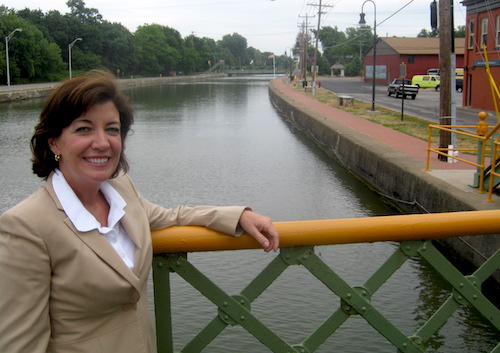Editorial: Hochul should put AIM funding for towns, villages near top of agenda

Photo by Tom Rivers: Kathy Hochul is shown at the Erie Canal in Albion in this photo from 2012 when she represented the community in Congress. Hochul is very familiar with the local small towns and many of the elected officials.
Kathy Hochul takes the reins as governor of the state today. She is facing major challenges on many fronts, including the reopening of schools in a safe manner during the Covid pandemic.
Many businesses still are reeling from the pandemic and state-imposed restrictions last year. The economy has been battered, especially in New York City which is fueled by so many tourists and the travel industry.
The rural areas of the state are seeing a major population exodus. Orleans County is down 5.9 percent of its population from 2010 t0 2020, or a drop of 2,540 people from 42,883 in 2010 to 40,343 in 2020. The percentage loss is the steepest in Western New York and among the highest in the state, where 39 out of 62 counties lost population, despite an overall increase of population of nearly 800,000 in the state. Those gains were mainly in the bigger counties.
Hochul will give an address at 3 p.m. today, outlining her priorities as governor. She won’t have much of a grace period. She is filling out a term that ends in about 16 months on Dec. 31, 2022. The gubernatorial race has already kicked into gear for next year. Hochul is the 57th governor in the past 244 years and the first woman.
She is also a rare statewide official from Upstate New York, and even more rare are her connections and knowledge of small town New York.
Soon after she became lieutenant governor in January 2015, Hochul reached out to me to talk about Orleans County. We met at the Village House in Albion. She meets with many people in diners across the state.
My top issue for her to consider was the gross disparity in AIM funding, or Aid and Incentives to Municipalities. The Orleans Hub has written about this often with charts showing how little local villages receive compared to cities, despite offering similar services. (Click here to see a previous article about the AIM disparity.)
Villages with police and fire departments receive about $7 per capita in AIM, while cities with similar levels of services receive well over $100. In Buffalo’s case, the per capita aid is over $600. In the Village of Albion, it’s $6.41, about 1 percent of what Buffalo gets. Bumping the villages up to $100 per person in AIM funding would result in about a 20 to 25 percent tax reduction for the local villages.
The AIM rates should be tied to a level of services offered by a village or town, and should also consider a community’s wealth. The state ties its school aid to a community wealth ratio. If it did in a similar way with AIM, our most poverty-stricken areas – the villages – would get significant relief.
The AIM distribution hasn’t improved for towns and villages under the Cuomo Adminsitriation. In fact, he made it worse by grabbing some of the sales tax from counties and using that to pay part of the town and village AIM share, instead of using state funds. In this case he robbed from the poor to pay the destitute.
I’ve brought AIM up to Hochul other times over the years when she makes local appearances. She has cited state attention for the small towns through the $750 million annually available through the regional economic development councils. Some of that money includes $10 million for downtowns on an upswing. Medina has tried for this grant several times but has been denied so far.
The regional economic development grants are a competitive process, with communities vying against each other for the money. The grants tend to go to wealthier municipalities which have an army of city managers, economic development specialists, grant writers and in-house engineers. They can put together more compelling aplications.
In Orleans County, none of the villages or towns have administrators or dedicated economic development staff. The county as a whole has a staff of three working on attracting and retaining businesses. The regional economic development councils have favored the communities with more resources.
A simple way to helping the small towns would be giving them more AIM funding, at levels close to what the cities are getting.
Just look at the villages of Albion and Medina. In the 2010 census Albion had 6,056 people and Medina was at 6,065. Albion receives $38,811 in AIM or $6.41 per capita. Medina gets $45,523 or $7.51 per person.
The City of Sherrill, the state’s smallest city with 3,071 people in Oneida County, receives $372,689 or $121.35 per capita. Another small city, Salamanca in Cattaraugus County, gets $928,131 for a city of 5,815 people or $159.61 per capita.
Orleans County has the added disadvantage of not having a city in the county so none of our municipalities get propped up by the state with AIM funding. That hurts us when all of the neighboring counties have at least one city, where the property taxes are much lower than in our villages, mainly due to the state’s AIM formula.
This is an issue that should be near the top of the agenda for Hochul if she wants to help give the villages and smaller counties a fighting chance.




































































